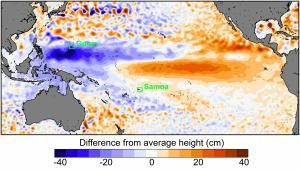Study Explores Sea Rise Doubling
A recent study conducted by two scientists at the University of Hawai’i at Manoa’s International Pacific Research Center, along with their colleagues from Commonwealth Scientific and Industrial Research Organization in Australia, explored sea level rise in the Pacific Ocean.
Matthew Wildlansky, Axel Timmermann, and Wenju Cai conducted computer modeling experiments and tide-gauge analysis to understand the culprit for potential frequent extreme inter-annual sea level swings.
The research trio are projecting a behavioral change of the El Niño phenomenon and its characteristic Pacific wind response.
Warm water and high sea levels shift eastward during El Niño, which leaves the western Pacific with low water levels. The east-west seesaw, followed by north-south sea level seesaw six months to a year later, can leave water levels dropped by up to one foot in the Southern Hemisphere.

Extreme low sea levels (purple) in the western Pacific are associated with the strong El Niño. University of Hawai’i at Manoa image.
These drops can expose shallow marine ecosystems in the South Pacific Islands, leading to massive coral die-offs and foul smelling tide, known as taimasa.
Wildlansky, Timmermann, and Cai explored the future greenhouse warming effect of El Niño sea level seesaws. Using state-of-the-art climate models, the scientists accounted for increasing greenhouse gas concentrations, along with simulations of the observed climate and tide-gauge records, to verify the model results.
It was determined that projected climate change will enhance El Niño-related sea level extremes. Results showed that by the end of the century, the experiments will show intensified wind impacts of El Niño and La Nina events, which are likely to double the frequency of extreme sea level occurrences, especially in the tropical southwestern Pacific.
“From our previous work, we know that toward the end of a very strong El Niño event, the tide-gauge measurements around Guam quickly return to normal reflecting the east-west seesaw, but those near Samoa continue to drop as a result of the lagging north-south seesaw,” said Widlansky. “During these strong events, the summer rainband over Samoa, called the South Pacific Convergence Zone, shifts toward the equator and alters the trade winds and ocean currents which in turn change the sea level.”
Timmerman believes the next logical step in their work is to understand future wind changes that are projected by most climate models. These models will impact the inter-annual swings in sea level.
“We noted a trend in greater variability and were surprised at first to find not only more frequent and prolonged drops in sea level, but also more frequent high sea level events,” said Timmerman. “This will further increase the risk of coastal inundations.”
“Our results are consistent with previous findings that showed the atmospheric effects of both El Niño and La Niña are likely to become stronger and more common in a future warmer climate,” said Cai.
Widlansky says that the possibility of more frequent flooding in some areas and sea level drops in others would bring severe consequences for coastlines already vulnerable in the Pacific Islands.
Better predictability of not only rising sea levels, but also the sea level fluctuations examined in the study, will aid Pacific Island communities in adapting to the impact of climate change, as well as shorter-term climate events like the ongoing 2015 El Niño.













